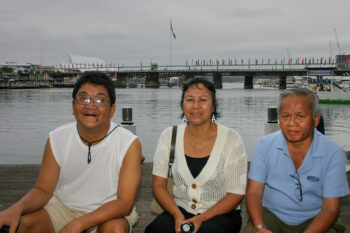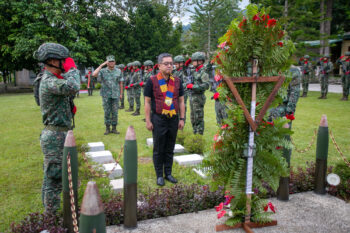
REVIEW:
Oras de Peligro
Produced by: Bagong Siklab Productions
Directed by: Joel Lamangan
Screenplay by: Bonifacio Ilagan and Eric Ramos
Cast: Cherry Pie Picache, Allen Dizon, Nanding Josef, Mae Paner, Therese Malvar, Dave Bornea, Allan Paule, Gerald Santos, Marcus Madrigal, Rico Barrera, Carlos Dala, Felixia Dizon, Jim Pebanco, Apollo Abraham, and Elora Espano.
CEBU CITY (MindaNews / 02 March) — Cinema – like social media – serves today as battleground of Truth Vs Lies. As has unfolded recently in this country, a film can either portray a historical truth based on undeniable facts or can be used as propaganda for purposes of disinformation.
Last year there was Vince Tanada’s KATIPS (profiling the brutal Marcos dictatorship) versus Darryl Yap’s MAID IN MALACANANG (an attempt to deodorize the downfall of the Marcos regime). Right now, it is Joel Lamangan’s ORAS DE PELIGRO versus Darryl Yap’s MARTYR OR MURDERER.
Of course it is not just here in the Philippines and in the contemporary period that films have been produced for propaganda purposes. Way back in the 1920s, the infamous Joseph Goebbels produced newsreels and short film-based news reports to glorify Nazism. And Leni Riefenstahl directed a film – TRIUMPH OF THE WILL – which glorified Adolf Hitler and his Nazi Party.
Hollywood, too, produced propaganda films which legitimized the U.S. government’s imperialist policies to subjugate the Native Americans and their neo-colonies in the Third World. These were especially the cowboy films where Native Americans were projected as the villains. One of these was D.W. Griffith’s THE BATTLE OF ELDERBURSH GULCH produced in 1914 where Native Americans were portrayed as the ones threatening the lives of a white family saved by the arrival of a cavalry that fought to subjugate the “savages.”
Closer to home – which arose long before there was such a thing as fake news peddled by social media – there was IGINUHIT NG TADHANA, a film produced by Sampaguita Pictures, directed by Jose de Villa, Conrado Conde and Mar Torres. Most probably commissioned by the Imeldific, this film romanticized her love story with the Ferdie who won medals for his supposed daring exploits during the WWII. Starring the popular duo Luis Gonzales and Gloria Romero (as the Marcos couple) it was a box-office hit and helped FM in winning the approaching Presidential elections.
From IGINUHIT NG TADHANA in 1965 to MARTYR OR MURDERER in 2023, the Marcos dynasty has emulated Goebbels’ fascination with film as propaganda, this time as a form of disinformation to glorify their patriarch’s tarnished legacy! Are we to expect more while Marcos Jr. is President? Will Daryl Yap be directing a war picture with FM as guerrilla to cement the claim of his medals? Or the Imeldific as the Tacloban Rose who morphed into a beauty queen and ultimately closed the doors of Rustan’s and even the boutiques in New York so she could shop to her heart’s delight?
Fortunately, film has also become one of the most effective media to portray the truthful reality of people’s lives as well as of events that had unfolded through humanity’s turbulent history. In the process they helped us learn the lessons of history as well as imbibe values that helped promote justice, peace and harmony among peoples of various ethnicities, nationalities, races, cultural and religious affiliation, genders and other issues of identity. And more often than not, they not only can be a source of entertainment (e.g. Charlie Chaplin’s silent comedy films) but also art films showcasing extraordinary talents.
Through the years, films – especially those in the tradition of social realism – including those of the Italian Luchino Visconti, Vittorio de Sica and Roberto Rosellinni, the Indian Satyajit Ray, the British John Schelesinger and Tony Richardson, the Mexican Alfonso Cuaron, the American John Cassavettes, Martin Scorsee and Francis Ford Copolla – have not only produced some of the best award-winning works but also challenged viewers to open their eyes to the reality of the world around them. Akira Kurosawa’s 1950 film – RASHOMON – is perhaps one of the most powerful films ever produced that help to convince the viewers to ever be critical in regard to distinguishing between truth and lies, fact and rumor.
We, too, have had our own share of social realist filmmakers whose films through the years have projected on screen the raw realities of our people’s lives as well as uncover the roots of our people’s oppression. Way back in the 1950’s golden years of film we had Gerry de Leon’s DAIGDIG NG MGA API, Lamberto Abellana’s ANAK DALITA and BADJAO and Manuel Silos’ BIYAYA NG LUPA. Fast forward to the 1970s/80s, and we had Ishmael Bernal’s CITY BY NIGHT and HIMALA, Lino Brocka’s MAYNILA SA KUKO NG LIWANAG and INSIANG, and Mike de Leon’s SR. STELLA L. And today, we can include the films of Lav Diaz, Brillante Mendoza, Erik Matti, Jun Lana and those from the regions (Sheron Dayoc, Teng Mangansakan, Arnel Mardoquio et al).
And there is Joel Lamangan. And with ORAS DE PELIGRO, he proves that he remains one of the Philippines important filmmakers. Although he has been accused of also directing commercial films that bowed to the pedestrian taste of the “bakya crowd,” nonetheless his impressive filmography has included films like THE FLOR CONTEMPLACION STORY, SIDHI, DEATHROW, HUBOG, AISHTE IMASU 1941, BLUE MOON, THE SARAH BALABAGAN STORY and MANO PO. Many of these have won awards at film festivals here and abroad.
With ORAS DE PELIGRO – a stunning, riveting and heart-wrenching but also thought-provoking film – Lamangan has set the record straight as to what really took place between November 1985 to the week in February 1986 when the world’s attention focused on the events unfolding at EDSA in Metro Manila that led to the downfall of the Marcos regime and the shameful exile of his family members and cronies to Hawaii, thanks to the hospitality of the U.S. government. This is cinema verite cum melodrama combining the best elements of documentary and feature films.
When the writers, director and producers discussed the film’s concept they must have struggled with how to tell the EDSA 1986 story but to avoid doing a documentary film whose story line is familiar with those who were already alive when such an event took place. To do so would just be repeating what already have been produced and could be so boring as not to attract viewers. If the intent was to draw in viewers especially of the millennial and Gen-Z generations – the youth who have no inkling what EDSA People Power was all about – then it has to be a film that would speak to the youth of today. There must be a story that would engage their attention and get them to empathize with the victims of the Marcos martial law regime and help them understand why there was this “bloodless revolution” that took place.
The result is ORAS DE PELIGRO’s bridging of a macro narrative (the events that led to and the unfolding of the EDSA People Power) with the appearance of key characters such as Ninoy and Cory Aquino, the Marcoses, Ramos and Enrile as well as the representations of the rebel soldiers, the Metrocom, the priests and nuns, the student activists, the Makati society matrons, the journalists and the “taong bayan” and the micro story of Dario and Beatriz, a couple whose family faced a tragedy in the midst of the unfolding of a momentous historical moment that would significantly alter the country’s political scene.
Dario (Allen Dizen) is a jeepney driver who finds it difficult to support his family especially at this moment when the turmoil in the Manila streets led to strikes further depleting his limited income. His wife Beatriz (Cherry Pie Picache in a film where she shows how excellent an actress she is!) is a housewife who must work as a domestic helper to make both ends meet. Their son Daniel (Dave Bornea) has been searching for a job but couldn’t find one and their daughter Nerissa (Therese Malvar) is having problems paying for school fees.
In the course of the film, Dario’s jeepney was held up as hold-uppers knew of a man riding the vehicle carrying a bundle of money. In the course of the action, the envelope containing the huge sum landed on Dario’s lap and he handed it to the Metrocom police who apprehended the hold-uppers. But one of the policemen shot Dario instead which then led to their accusation that Dario was in cahoots with the hold-uppers to cover up for their own corrupt act to keep the money themselves.
How the family tried to retrieve Dario’s body from the hospital morgue to the funeral parlor then to their house so they can hold a wake are juxtaposed with the unfolding events between February 22 and 26. And just as the deposed dictator and all his entourage flew to Hawaii, the family and their neighbors finally were able to bury Dario’s remains. But as this troubled family’s experiences are portrayed on the screen, the viewer gets to be exposed to the dehumanizing realities of those living in urban poor communities, earning livelihoods that barely make them survive, constantly beset with unemployment and poverty and too poor to claim their dead relatives’ remains and must rely on the generosity of others.
Ilagan and Ramos’ story is told within the backdrop of the momentous event that drew the attention of the world at a time when CNN began its 24-hour news reporting reaching millions across the world. Thus the screenwriters had to juxtapose news reports and archival documentary footages with the filmed segments of what was happening with Dario’s family. It is a challenging approach to filmmaking but somehow it works except that the quality of the footages lessens the impact of the dramatic shots.
The most outstanding feature of the film is the ensemble acting of every cast member from the main leads to all those providing support, even those that appear only in one scene. Picache stands out because her role is at the center of the narrative and fortunately she delivers in a performance that is a showcase of excellent method acting that will surely bring her accolades in next year’s award season! Unfortunately, the fine actors – Allen Dizon, Nanding Josef and Alan Paule – have limited presence in the film but when they appear, they hold the viewers’ attention.
There is only one reason for the high calibre acting in ORAS DE PELIGRO and it is the ability of Joel Lamangan as Director to elicit from his actors – veteran as well as newcomers, and even among the extras – the best performances possible. While some scenes are staged as if the actors were on stage (influenced by Lamangan’s long years of working with PETA’s theatrical productions), most scenes do have the feel of unfolding in the everyday.
At roughly 1 hour and 40 minutes long, ORAS DE PELIGRO manages to capture a historical narrative that unfolded within four months while profiling an urban poor household whose lives are impacted with a significant national event and thus showing how the poor became poorer during the Marcos regime and why some of them joined in the protest movement culminating in the people’s uprising. In the process the older viewers are able to once more be reminded of an important historical moment in our Republic’s history while the younger ones are provided a factual account of what took place which should have discredited the Marcoses once and for all!
The film, of course, is not without flaws. One can understand there are limitations to the budget so some crowd scenes cannot be staged in the manner that would correspond to the multitudes that gathered at EDSA. Thus, the reliance on raw documentary footages. Its ending leaves much to be desired; the quick shift between the funeral scene at the cemetery and the crowd led by Beatriz to march to Malacañang was a bit contrived. The politically correct viewer will gripe that nothing at the end of the film would provide a short commentary on the failure of the EDSA 1986 and Mrs. Aquino’s to prosecute the Marcoses and their cronies which has led to their return to power.
And in a way, the film romanticizes the “bloodless revolution” as if it was really a revolution! While the film’s writers uses two characters who are student activists to make a comment that what was happening was not a genuine revolution – in the sense that it not only gets rid of a dictator but radically changes society’s oppressive structures – these comments are said in passing and not deepened in the course of the film’s narrative. Perhaps Lamangan and the producers might consider a Part II that critiques EDSA 1986 and present where the country is at 40 years later – which is to suggest that EDSA 1986 did not make a major difference in the lives of the poor!
But despite its flaws, ORAS DE PELIGRO is a film that every Filipino must see especially the youth of this land! It will reveal to them the facts of what took place in the past, help them to learn lessons from history, make them appreciate their elders who took sides during the country’s turbulent martial law era and entice them to make their own commitments today to help build a more free, just and sovereign Republic. And in the process, appreciate what an art film is all about!
The exorbitant price today of cinema tickets may prevent our youth from watching this film in the Cineplex, so we can only hope that the film’s producers along with various institutions (schools, NGOs, faith-based groups and others) could sponsor showings in various venues that would make it more affordable. But while you may have the money and while the film is still showing (it is supposed to be shown in SM cinemas across the country), go watch ORAS DE PELIGRO today! And be part of the crowd that champions the TRUTH!
(MindaViews is the opinion section of MindaNews. Redemptorist Brother Karl Gaspar is Mindanao’s most prolific book author. Gaspar is also a Datu Bago 2018 awardee, the highest honor the Davao City government bestows on its constituents. He recently moved to his new assignment in Cebu City.)







